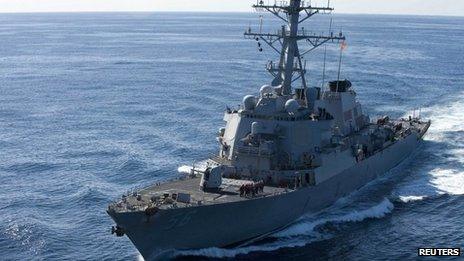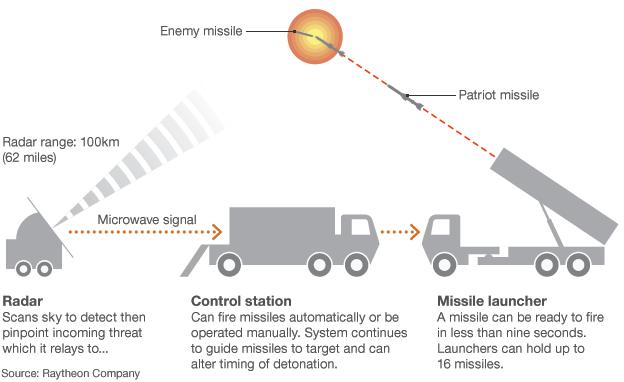North Korea threats: Missile defences in the region
- Published
The US has deployed missile defence systems in response to North Korea's threats against its neighbours.
The defences, which have the capability to shoot down missiles inside and outside the Earth's atmosphere, will be ready within weeks, the Pentagon says.
Along with the US, North Korea's neighbours Japan and South Korea also have missile defences in the area.

Japan: Patriot Advanced Capability-3 missile defence systems; warships with Aegis anti-missile capability
South Korea: Patriot Advanced Capability-2 defence systems; warships with Aegis anti-missile capability also deployed
Guam: US Terminal High Altitude Area Defense System (Thaad) to be deployed
Regional waters: US Aegis-equipped warships USS John McCain and USS Decatur have moved to the Western Pacific in recent days
What missile defence systems are in the region and how do they work?
Aegis missile defence system

USS John S McCain is in the Western Pacific
The Aegis system allows warships to shoot down enemy ballistic missiles while they are still in space.
The interceptor missiles are fired to hit missiles before they re-enter the atmosphere, stopping them well before there is any danger of causing any damage.
The US Navy, South Korea and the Japanese Maritime Self-Defense Force all have destroyers in the region with Aegis capability.
Terminal High Altitude Area Defense System (Thaad)
The Terminal High Altitude Area Defense system, or Thaad, is being developed as a rapidly-deployable system capable of defending against short and medium-range ballistic missiles during the late-mid-course and terminal phases of their flight.
The system - being deployed by the US to the Pacific island of Guam - can destroy enemy missiles at ranges of 200km and at altitudes up to 150km and is used to protect high-value strategic or tactical sites such as airfields or populations centres.
Thaad has been much delayed in development and the Guam deployment will be its first real mission. The first two of nine planned batteries were only scheduled to be delivered to the US Army in 2012.

1. The enemy launches a missile
2. The Thaad radar system detects the launch, which is relayed to command and control
3. Thaad command and control instructs the launch of an interceptor missile
4. The interceptor missile is fired at the enemy projectile
5. The enemy projectile is destroyed in the terminal phase of flight
The launcher trucks can hold up to eight interceptor missiles.

Patriot air defence system
The Patriot is an advanced surface-to-air missile system intended to defend against aircraft, cruise and ballistic missiles.
It is the third layer in the defence shield and is used to stop weapons at close range.
The key elements are radar, the control centre and the launchers mounted on trucks. Each launcher holds four missiles - or 16 in the latest "Pac-3" version.
South Korea and Japan both have Patriot systems.

Full Patriot fact file.